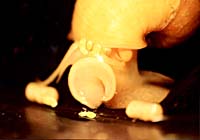Food |
| Guide for keeping apple snails |
Food |
Apple snails eat a wide variety of vegetables.
Although your aquarium might by full off plants, the snails will hardly eat
them until they are almost starving.(*1)
Apple snails prefer dead and sick plants above healthy ones, so you shouldn't
fear the end of your aquarium plants when you put apple snails with them.
It's a good thing to feed your snails with vegetables like lettuce and cucumber in
combination with fish food. Very handy types of fish-food are the tablets sold for
algae-eaters, but other types of fish-food will do as well. If you like to keep the
expenses low, just buy pond-fish food. This comes in a big quantity for a low price and
has a big advantage: it floats. Although that might seems a bit strange for snail-food,
believe me, apple snails know very well how to get floating food. They go to the surface
and form a tunnel with their foot in which they let the water from the surface flow
through. The food at the surface then floats towards the snail and gets stuck in the
tunnel form by the snail's foot.

In the picture above, you can see a snail eating from the surface. The two cylinders
you see are pond-fish food pellets.
If you want your snail to get out of the water, just attach some food partly above the
waterline. It's because of this behaviour (leaving the water to get some food) which makes
them such a problem in the rice-fields of Asia.
Housing |
Water:
Apple snails don't make high demands on the water quality. From clear, streaming,
oxygen-rich water till still water full of rotting organic waste, containing almost no
oxygen. It's no problem for them. By the way, they are very good indicators for the
oxygen-level in your tank. When there isn't much oxygen in the water, the snails will come
often to the surface to inhale air through their breathing siphon. If there is enough
oxygen in the water, they don't need their lung and solely use their gills.
Like most snails, apple snails prefer calcium rich water.
Light:
Apple snails are most active during the night, which already indicates that they prefer
the darker places of their environment. During the day, they remain mostly in the shadow
of plants and creep away in the mud. In the evening they get more active and then they can
be found closer to the surface. At night they sometimes even leave the water for a short
time, so it's not a bad idea to close the lid of your aquarium at night otherwise you
could find your snail on the floor next day.
Room:
As a general thumb-rule: at least 10-liters/2.5 gallon for each mid-sized snail
(±5cm/2inch. diameter).
Temperature:
Keep the temperature between 18 and 28°C (65-82°F) to make your snails happy.
Reproduction |
Eggs:
When the apple snail eggs are laid, they are soft and have a rather milky colour. After a
few hours, they harden and get their definitive colour. It might happen that the eggs at
the surface dry out, on which they get a lighter colour. The eggs at the surface probably
won't deliver you snails, but the eggs deeper in the clutch will.
It's no problem to move the eggs in case you don’t want the hatch them in your
aquarium. The best way to do this is by wetting the clutch, wait a few hours and then
carefully move the clutch over the surface it's attached to until it comes off.
It's important to keep the eggs in a moist, but not wet environment. Never keep the eggs
under water (this will drown the young snails). Keep the temperature between 18 and 28°C
(65-82°F). The higher the temperature, the faster the snails will hatch.
After 5-7 weeks the first snails should appear. If they don't, you can help the young
snails. It might seem rude, but it's really working: just break the clutch in 2 - 3 parts
and lay them in the water. You can even wash the snail out of the clutch by moving the
broken clutch parts in trough the water.
To my experience, this method gives you many healthy young snails.
You might want to wait until the snails appear on the natural way, but keep in mind that
if the clutch isn't kept moist enough, the young snails won't be able to make their way
out and die.
Note 1, 2003: Only the species Pomacea diffusa does not eat plants, other species can be voracious eaters that eliminate all vegetation.
[Introduction] [Food/reproduction] [Anatomy] [FAQ] [Photographs] [Links] [Design]
(c) 1998 by Stijn Ghesquiere
All rights reserved.